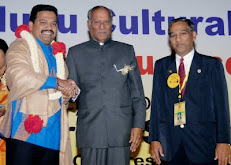I would like to direct this piece of my writing to all the well-known personalities of Telugu Film Industry, which includes the directors, producers, actors, actresses, technicians etc.
Here in Malaysia we have been deprived of all the thrills and chills, which we get while watching our favorite actors and actresses movies. All over the world i.e. USA, UK, DUBAI, SINGAPORE etc. Telugu movies are being screened but not in MALAYSIA. Why is this apathy towards Malaysia? Here we are in big number. I am talking about Telugus from Andhra Pradesh. Surely any producer can screen his movie for at least 3 days and make handsome profit. Here we are around 4000(approx). Another plus point of screening a Telugu movie is there are nearly 3 lakh local Malaysian Telugus. Among them at least 50% are still following our Andhra tradition and customs, which is very much evident when we go for UGADI or any other festival celebrations here. They do follow all the happenings in our state Andhra Pradesh and do feel very proud talking in Telugu even though it's not at the purest form.
Till yesterday somehow we used to get the newly released Telugu VCD's (pirated one's) in the 2nd week of the movie release in ANDHRA PRADESH. But now that too has dried out because of serious action taken by our film industry. There seems to be a sudden lull among the telugu movie lovers here as none of the new movies are being released through VCD's and if we get those pirated versions (they are just awful) we just cannot watch them because the prints are too bad to even watch for 10-15 minutes. So what to do? Where to watch the movies? Previously two movies namely "VASU" and "SANTOSHAM" were screened using a projector and DVD simulation, which was sort of OK. But the thing over here was we somehow watched the movie on a bigger screen rather than watching in our television sets. It was ok but once the organizer got summons from the Telugu film industry there has not been a single movie till date. Let me tell you one of the bad experiences, which I had very recently.
The date was announced i.e Aug 31,2002. It was a weekend. The expectations were high. A CHIRANJEEVI movie, "INDRA", for the first time in Malaysia. For weeks, I had been following the updates on the latest buzz on "INDRA". Here almost all the tickets were sold. We all have really planned everything for that day. Neither a crashed server (as most of the guys here are in to software industry) nor a severe thunderstorm could stop us from being at the theater on that day.
All of us were very anxious, rife with expectations, enlightening the ones who didn't have too much knowledge about the movie "INDRA" as it has already released in Andhra Pradesh and USA, creating havoc among the public, along with Chiru's sagas and lore. As the day was nearing the anticipation levels had soared sky high. But I wished that anticipation was fulfilled. Just the day before, the writing was on the wall. The show was cancelled because the organizer got a call from MR.ASHWINI DUTT's office in Hyderabad. The expression on the enthusiastic fans faces was akin to a situation if batsmen Sachin Tendulkar were to get out on a low score at a key cricket match. At the cancellation of the movie, I had seen people who were very much seesawed between the ecstasy of expectations and agony of the cancellation of the movie.
As I already wrote about two movies being screened earlier, both the movies went fulls with the ticket rate at RM10/- & RM13/-. Nearly 500 people watched the movie. Screening of "INDRA" was also planned in the same way but one call from the producer's office has jeopardized the so-called screening of the movie "INDRA". Till date we couldn't see the movie. What do the producers expect us to do? Go to India and see the movie, which is like asking too much from us. And when we read articles on the movie celebrations around the world we feel very happy and at the same time get frustrated beyond control. Somebody from the industry has to understand our plight and do the needful. Even we want to enjoy the movies like the Telugites in USA, UK, DUBAI, SINGAPORE.
So my sincere wish to all the well known personalities of our blossoming and evergreen Telugu Film Industry is either let the VCD's be released by the 2nd week (obviously I am referring to the pirated one's) or else please do the necessary arrangements to screen the telugu movies her also in Malaysia and do let us also enjoy the telugu movies like everyone elsewhere in the world.
I Hope my letter reaches all the concerned people of the film industry and I very much strongly hope that my favorite film website which is none other than "idlebrain.com" would lend a helping hand in making the Telugu movies reach thousands of hungry Telugu movie fans here in Malaysia.
cheers,
shyam akkisetti
cheers,
shyam akkisetti



.jpg)
.jpg)
.jpg)
.jpg)
.jpg)

